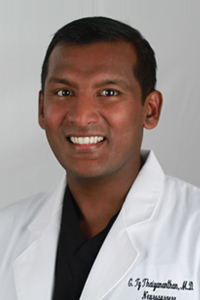 More spine practices today are looking to expand beyond just neurosurgeons and spine surgeons to include non-operative care and pain management. Founder of BASIC Spine in Orange, Calif., Ty Thaiyananthan, MD, talks about expanding his practice into a multispecialty spine care center and where he sees this model heading in the future.
More spine practices today are looking to expand beyond just neurosurgeons and spine surgeons to include non-operative care and pain management. Founder of BASIC Spine in Orange, Calif., Ty Thaiyananthan, MD, talks about expanding his practice into a multispecialty spine care center and where he sees this model heading in the future. Q: How has your practice grown from a spine surgery-focused practice into a comprehensive, multispecialty group?
Dr. Ty Thaiyananthan: We are a multispecialty group that includes both orthopedic and neurospine surgeons along with pain management specialists. Our model also includes physical therapy, chiropractors and pain management psychologists all under one roof. We were all single practitioners and we decided to come together so we can offer more comprehensive care and better care for patients who walk through the door.
Q: What advantages do you find in the multispecialty spine care model?
TT: We found from looking at our outcomes measures we are able to produce better results with this model. Patients are happier and they have several different specialists working with them to relieve their pain. When the patient comes in with a spine problem, based on what treatments they've had in the past, we can work them up the ladder of conservative management to interventional pain management, diagnostic evaluations and then provide surgery for surgical candidates.
If a patient who isn't quite ready for surgery comes to my office, I don't have to reschedule them. I can actually walk the patient across the hallway to the pain clinic and help them get something definitive done. I can also work with the pain physician on a single case to make sure the patient is getting the right treatment. Having two sets of eyes optimizes care, and we can do it all in real time.
Q: What is the most challenging part of having all the different spine specialists under one roof?
TT: The toughest part is logistics because you have to coordinate multiple different specialists and service lines into one center. That was a really big functional change and you have to have close collaboration to make a model like this work.
When we first came together, we wanted to develop protocol for new patients, as well as follow up with our current patients to make sure they are seen by the right specialists at the right stage in their treatment. To coordinate that has been challenging, and we actually hired a consulting service to sit in the room with us as we talked about putting together a treatment plan; they were able to solidify our thoughts into something concrete.
Now we have a check-in process and vetting process to see where people would fit based on past treatment. We try to figure out whether the patient needs physical therapy, pain management, chiropractic care or another conservative treatment. Having everyone in the same room as we devised the treatment pathway and protocol was absolutely vital.
Q: How has this multispecialty model changed your practice of spine surgery?
TT: The people I'm seeing in my practice are truly surgical, so I'm not spending time sending patients to a pain management specialist. It's a more efficient use of our time and integrating the different service lines brought additional profit lines into our practice as well.
Q: When new patients arrive at the center, who guides them to make sure they are seeing the right specialist?
TT: We have a nurse navigator who coordinates our new patients. We also have customized software that helps coordinate and fast track patients into different treatment plans. For example, if a new patient who is 30 years old and has only had back pain for a few months, our clinical coordinator will work with that patient on a physical therapy program. However if a 65-year-old with prior history of back surgery and chronic pain comes in, and an MRI shows disc herniation, that patient will be screened by a nurse navigator and likely schedule an appointment with one of the surgeons.
There is an intuitive algorithm in our software to help us identify these patients and set them on the right track. The patients are happy because it's the shortest route to giving them treatment and they aren't wasting their time with the wrong specialist.
Q: Where do you see the multispecialty spine care model headed in the future?
TT: I think it's going to be mandated by accountable care organizations. As more of healthcare is determined by outcomes and quality measures, as well as cost savings, it's really going to be efficiency and making sure you get quality care for the patients. Minimize wait times and optimize the patients' healthcare dollars, which is what multispecialty practices do. We can give patients a definitive answer about their care without having them go through the medical mill.
Dr. "Ty" Thaiyananthan is the founder of BASIC Spine in Southern California. BASIC specializes in complex and minimally invasive spine surgery and is at the forefront of pioneering new surgical techniques using stem cells and minimally invasive surgery to treat chronic neck pain.
Dr. Ty earned his medical degree from UCSF, did a general surgery internship and neurosurgery residency at Yale and completed a surgery fellowship at Cedars-Sinai Medical Center in Los Angeles. Follow Dr. Ty on Google+.
More Articles on Spine Surgeons:
5 Ways for Spine Practices to Stay on the Cutting Edge
Innovative Trends in Spine Surgery Technology: Q&A With Dr. Lawrence Dickinson
5 Factors Influencing Spine Fellows Turn Towards Academia


